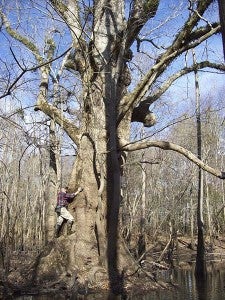Southampton trees receive Champion Tree designation
Published 9:38 am Friday, December 5, 2014
FRANKLIN
Byron Carmean, a retired teacher, now spends his spare time in North Carolina and Virginia in search of trees. Not just any old tree, however, as Carmean sets his sights on the largest trees of each species in both states. Carmean often ventures into old cemeteries, national parks and swamps in hopes of finding what is known as a Champion Tree.

Byron Carmean of Suffolk poses with the National Champion Overcup Oak on the Blackwater River near Zuni, which he submitted to the American Forests national conservation group. The tree, scientific name Quercus Lyrata, is registered as the largest in the nation of its species. — COURTESY | ROBERT LLEWELLYN
“There are three measurements that go into naming a Champion Tree, which includes the circumference, the height of the tree and the crown spread, otherwise meaning the width of the branches across,” he said.
Carmean, a horticulture and forestry teacher of 30 years, has been credited with finding more than 100 State and National Champion Trees in Franklin, Southampton and Isle of Wight counties alone.
“I believe that Southampton County has more champion trees than any other county in Virginia,” he said.
Carmean’s assumption was right, as Southampton County leads all counties in Virginia with 52 Champion Trees, although a number of independent cities in the state have more. In fact, the city of Norfolk counts 102 champions, with the majority located at the Norfolk Botanical Gardens.
Additionally, Isle of Wight County claims 38 Champion Trees, while the city of Franklin counts six.
When describing the process of naming a Champion Tree, Carmean noted that the measurements used are standardized throughout the country so that the trees can be compared and named national champions.
“To determine the champion of a specific species, you take the circumference in inches plus the height in feet plus one-fourth of the crown spread,” said Carmean. “The circumference has to be larger than 4-½ feet to qualify, and if you add those measurements together you get a point value. That point value determines which is the greatest of one specific species.”
He explained that there are a number of rules that apply in order for a tree to be eligible, including if it’s oddly shaped or damaged, but it is most important that the tree is indigenous or has been naturalized without assistance from humans.
“The only trees that meet qualifications to be considered state or national champions are those that are native or naturalized to the state or country,” said Carmean. “While native is more obvious, naturalized means that the tree was brought from a foreign source, in this case birds or other animals, but has continued to thrive in the environment on its own for quite some time.”
The list was first created in 1940, when the American Forests’ National Big Tree program began promoting the importance of planting and caring for trees and forests to help sustain a healthy ecosystem. The program campaigned to locate and save the biggest trees in the United States, and has since honored those champions in the National Register of Big Trees.
Carmean said that Dr. Eric Wiseman of the Department of Forestry at Virginia Tech has compiled the list of State Champion Trees in the Virginia Big Tree Database, featuring tabs that list the trees by their common and scientific name, cities and counties or states.
If a tree happens to be significantly larger than the others in its species, it’s likely that it’ll be listed in the American Forestry Association’s National Register of Big Trees.
“Virginia is actually ranked fifth of all of the states when it comes to National Champion Trees,” said Carmean. “There are 65 national champion trees in Virginia, including six in Southampton and two in Isle of Wight.”
For more information, visit www.americanforests.org or bigtree.cnre.vt.edu.





